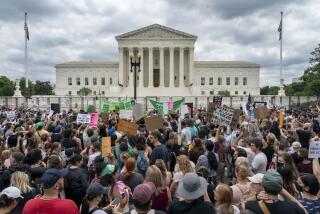Fewer Women Get New Heart Attack Treatment : Health: Study confirms a previous report, raising concerns that there may be bias in medical treatment.
- Share via
ANAHEIM — Although almost as many women as men die of heart disease each year, women are only half as likely to receive state-of-the-art heart attack treatment, according to a new study that researchers say suggests once again a possible treatment bias against women.
The study, reported Tuesday at the annual meeting of the American Heart Assn., found that 26% of men hospitalized for heart attacks received “clot buster” drugs to restore blood flow to the heart. They found that only 14% of women received the drugs.
The researchers also found that men were twice as likely as women to undergo angioplasty, a method of reopening clogged arteries by inflating a tiny balloon on the tip of a catheter to flatten the blockages in the vessels.
The findings confirm and expand upon the results of studies published last summer, which found that women were less likely to receive radiological tests for blocked vessels, an artery-clearing procedure called revascularization and coronary-artery bypass surgery.
The authors of the new study conceded there may be valid medical reasons for some of the discrepancy, but Charles Maynard, one of the researchers, said the findings also raise “concern that there may be a bias in the use of treatment.”
About 48% of the 500,000 Americans who die of heart attacks each year are women.
In the study, researchers from the University of Washington in Seattle examined the records of 4,891 men and women hospitalized for heart attacks. On average, the women were older than the men and had more severe heart disease, including high blood pressure.
Maynard said that both angioplasty and clot-busting drugs are as safe for women as for men and that there is no evidence that women stand to benefit any less from them. He said it is not clear what conditions or medical factors might explain the gender gap and he intends to study that next.
Dr. Douglas Weaver, a co-author, said that there may be true bias but that women may also experience heart attacks in a different way than men do. If that is true, their physicians might miss the heart attack initially and fail to treat it.
In a separate study presented Tuesday, a University of North Carolina cardiologist suggested that blacks may be less likely than others to feel a characteristic warning sign of a heart attack and, for that reason, may delay seeking medical attention.
Such a delay, even a matter of hours, is often critical. Drugs that treat heart attacks by breaking up the blood clot that is blocking an artery to the heart muscle must be taken within six to eight hours of initial chest pain. Delays in treatment can result in irreversible heart damage.
Dr. Ross Simpson studied 83 men and women who had heart attacks. He found that blacks waited an average of 23 hours before seeking treatment, while whites waited eight hours. Simpson also found that the two groups described their pain differently.
Simpson found that while tightness in the chest and pain radiating down the arm are considered classic indicators of heart attack, black patients instead described a feeling of suffocation or a sharp, stabbing chest pain.
Simpson speculated that social, economic and other environmental factors influence racial differences in the perception of pain.
In another study, researchers said digitalis, one of the oldest and most widely used heart drugs, significantly increased the risk of sudden death in people who had survived a heart attack, a study shows.
One million Americans survive heart attacks each year, and about 25% of them are treated with digitalis, said Dr. Arthur Moss of the University of Rochester Medical Center. Moss did not say that patients who use digitalis should be taken off the drug. He said further study is needed to identify which patients face increased risk of sudden death.





